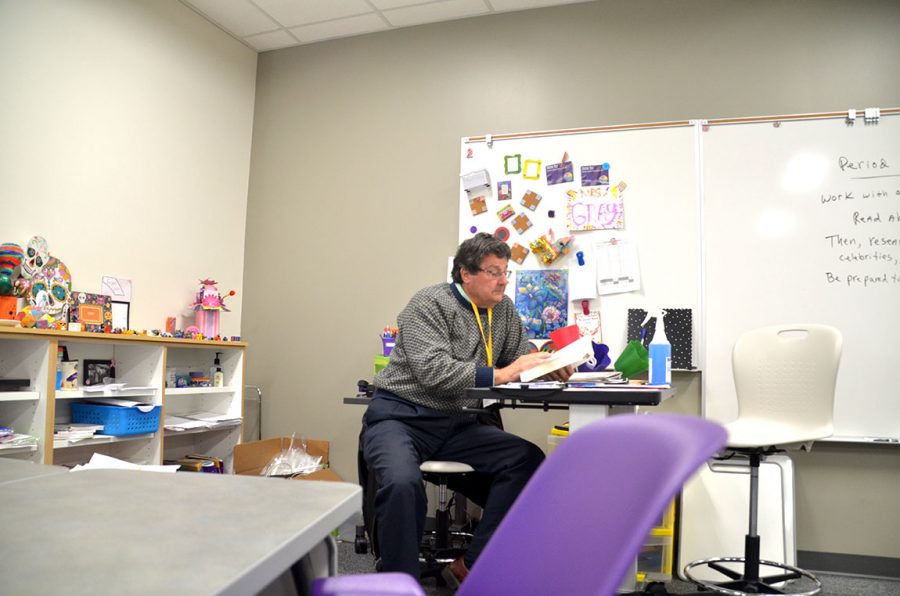The state-wide substitute shortage
“Yes, they’re not your normal teacher, but they all have something to teach you,” Greta Standish.
Substitute Bruce Demsky reads a Spanish dictionary while substituting for Kari Gray’s French I class.
January 4, 2018
When chemistry teacher Jennifer Lehman’s sixth-period students walked into class they were expecting to find a substitute. Instead, they found chemistry teacher Chris Siewert playing the part of Jennifer Lehman. This situation is not uncommon considering the state as a whole is experiencing a substitute shortage.
In the state of Iowa, there are three ways to become a substitute: hold a valid teaching license, hold a paraeducator license, or obtain a substitute authorization. Any individual that holds a valid teaching license is qualified to substitute for an educator. If a class has an associate in the room as well as a teacher, that associate may get their paraeducator license, which allows them to substitute in that specific classroom in the teacher’s absence. If an individual has a four-year degree but not a teaching license, they may take a class at Heartland Area Education Agency (AEA) and receive a substitute authorization. However, there are some caveats that come along with the substitute authorization because the individual is not a licensed teacher and they may not hold the same substitute position for more than five days in a row. They could not become a long-term sub, but they are allowed to intermittently drop into different jobs at different levels.
As of 2017, nine percent of all substitute positions are unfilled, leading to teachers taking the place of substitutes. When the substitutes are not available, teachers receive emails requesting coverage during specific periods. Full-time teachers have two periods a day where they do not teach. One of these periods is usually filled with duties such as study hall, sophomore house, or lunch duty. The remaining period is a planning period. These planning periods are often the first to be given up when teachers have to cover each other. “Well, if we have to cover for each other, that means there are going to be people throughout the course of a week who don’t get as many planning periods. A lot of us do that if we are able to because we want somebody to do that for us if we are ever the one that is gone but it does make it challenging though because you have [a teacher] who is coming in and had five minutes to look at things in order to try and teach a quality lesson to students, as opposed to a sub who has been there the whole day,” History teacher Jessica Dowell said.
Substitutes may also end up unexpectedly covering for additional teachers. The JCSD board of examiners has taken measures to try and increase the number of substitute teacher days and they recently increased the number of days a substitute can teach from 90 per year to a full 180. The district is also currently in the process of calling any substitute who has not taken a position this year and asking them if there is a reason or a barrier for them not working in JCSD, such as finding full-time employment elsewhere or preferring to work in other school districts. “It can be really hard for teachers when they don’t know the sub coming in because then they don’t know if teach their subject and handle a classroom,” Substitute teacher Greta Standish said. “Sometimes it’s a hit or miss with some of the subs, and this way they can decide whether or not they’re going to just give the sub a movie to show or, like in my case, I was able to do a simulated crime scene because the teacher knew that I was able to run a lesson and that I would enjoy running the lesson.”
Executive director of human resources Laura Kacer prefers that this be the case in every classroom with a substitute teacher, however, Johnston does compete with the other school districts in the metro area for the same pool of people, such as retired teachers who want to work every once in awhile, a new substitute who has no prior experience or a person who has decided that they would rather have the flexibility that substituting offers over being a contracted teacher.
Students behavior may also be a contributing factor to the sub shortage, “I think the students should try to listen to the subs expectations a little bit better, because I’ve talked to students and I’ve heard some of the things that they’ve done to subs and that’s not respectful at all. The students need to realize that it’s not easy walking into a classroom cold, with kids that you don’t know. The students could do a better job of respecting the subs or giving them a chance, which they don’t always do. A lot of times, students will go in and say ‘look there’s a sub, game on,’ and I’ve heard sometimes they walk out or they just immediately stop listening. I really think that they need to take a step back and realize that it’s hard walking into a classroom of 30 adults, for the most part, that you don’t know and you’re trying to teach them. You kind of need to sit back and give them the opportunity to share their knowledge, and I think that the students are not giving them that opportunity. You can’t just say, ‘I don’t know you so I’m not going to listen to you’, that’s just not fair. When they’re telling me ‘oh yeah I didn’t like the sub, I walked out’, that’s not ok. Then I ask them, ‘would you walk out on me?’ and they go ‘no’, so why would you walk out on that sub? They definitely need to be more respectful and that’s what bothers me. The lack of respect so many students have for subs needs to be worked on, and I don’t think it’s appropriate. They need to stop taking advantage of the subs,” Standish said.
Kacer has also had occasions where she has needed to intervene on behalf of the students because the substitute had developed a bad reputation,“If we have somebody who’s extremely problematic, whether that be a student or the adult that we invite in, we need to address those, and we’ve done that in the past as well, and will continue to do that in the future,” Kacer said. “Sometimes it’s just not a good fit, or that person’s philosophy doesn’t match what our philosophy in Johnston is about teaching and learning,” Kacer said. Instances like these are rare.
Although Standish enjoys being a substitute, she wishes that students would be more accommodating to her position. “I don’t think anyone finds it comfortable to stand up in front of thirty strangers,” Standish said. “The students need to put themselves in their [the sub’s] shoes and give them a chance, instead of just treating it as a free for all, which is what so many students do.”





